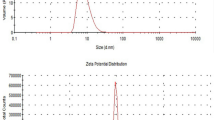Abstract
PEACOCK1 induced hepatomas in seven of seventeen mice surviving subcutaneous injection of oil orange E (1-benzeneazo-2-naphthol) for more than fourteen months. This substance was then in use as a food dye. Clayson2 has since suggested that it might be active by virtue of its in vivo reduction to 1-amino-2-naphthol. If this be so, it was thought that other compounds capable of being reduced to this amino-haphthol might be carcinogenic.
This is a preview of subscription content, access via your institution
Access options
Subscribe to this journal
Receive 51 print issues and online access
$199.00 per year
only $3.90 per issue
Buy this article
- Purchase on Springer Link
- Instant access to full article PDF
Prices may be subject to local taxes which are calculated during checkout
Similar content being viewed by others
References
Peacock, P. R., Ann. Rep. Brit. Empire Cancer Campaign, 26, 198 (1948).
Clayson, D. B., Brit. J. Cancer, 7, 460 (1953).
Author information
Authors and Affiliations
Rights and permissions
About this article
Cite this article
BONSER, G., CLAYSON, D. & JULL, J. Induction of Tumours with 1-(2-Tolylazo)-2-naphthol (Oil Orange TX). Nature 174, 879–880 (1954). https://doi.org/10.1038/174879b0
Issue Date:
DOI: https://doi.org/10.1038/174879b0
Comments
By submitting a comment you agree to abide by our Terms and Community Guidelines. If you find something abusive or that does not comply with our terms or guidelines please flag it as inappropriate.



